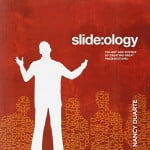Slide:ology by Nancy Duarte: Create Moving and Amazing Presentations


This is Nancy Duarte’s magnum opus. It’s the best book she’s written and the one that every presenter, coach and slide design should read from cover to cover every couple of years. It’s Garr Reynolds‘ favourite book on presentations too. Duarte has become the doyenne of presentation designers since the publication of this book back in 2008. Slide;ology changed the world of presentations and helped Duarte and her design and communications business to grow into the $25m business that it is today.
Slide:ology is an easy-to-read masterclass which will help you create presentations with that bit more impact than they’d have if you didn’t read the book. It makes advanced presentation design and slide creation possible for anyone with a bit of nous and a strong desire to stand out when they stand up to speak.


It is not a “Powerpoint” manual but gives useful tips on the effective use of visual aids for all kinds of presentations. It ‘starts with the question why visuals at all?’ and then helps you to create visuals that work for the audience and the speaker.
Slide:ology isn’t all about the slides though, it’s a great introduction to the three pillars of presentation competence – create a strong story, illustrate with simple visuals and deliver with conviction – and it’s a beautifully designed, well structured and passionate call to action to do a few simple things better.
Slide:ology Contents
The book has twelve chapters: (1) Creating a New Slide Ideology; (2) Creating Ideas, Not Slides; (3) Creating Diagrams; (4) Displaying Data; (5) Thinking Like a Designer; (6) Arranging Elements; (7) Using Visual Elements: Background, Color, and Text; (8) Using Visual Images; (9) Creating Movement; (10) Governing with Templates; (11) Interacting with Slides; (12) Manifesto: The Five Theses of the Power of a Presentation.
Highlights for the designer, coach and presenter
For the “amateur” designer/presenter, the section on Using Visual Elements: Background, Colour and Text provides particularly valuable guidance on the fundamentals. It may seem pedantic to seek perfection in these matters but it does actually matter! Duarte reinforces this message with many clear examples.
The amateur designer will thank Duarte for the simple tips to make their own poor efforts look less ‘homemade’ than most and better than a lot of ‘professionally designed’ slides which tend to have far too much content and clutter on each slide.
The professional designer will enjoy this book for its many case studies, anecdotes and principles all presented in a clear, approachable manner. They will be able to build their skills through the experience that so obviously inspires the book.
Duarte’s Five Theses of the Power of a Presentation
Duarte boils all of her content down to a bite sized ‘Big Idea’ to help the reader remember what’s in the book and put it all into practice in the real world. Her 5 theses are:
1. Treat Your Audience As King
They didn’t come to your presentation to see you. They came to find out what you can do for them. Provide content that resonates, and ensure it’s clear what they are to do.
2. Spread Ideas And Move People
Communicate your ideas with strong visual grammar to engage all their senses and they will adopt the ideas as their own.
3. Help Them See What You’re Saying
Think like a designer and guide your audience through ideas in a way that helps, not hinders, their comprehension. Appeal not only to their verbal senses, but to their visual senses as well.
4. Practice design, not decoration
Don’t just make pretty talking points. Instead display information in a way that makes complex information clear.
5. Cultivate healthy relationships
Display information in the best way possible for comprehension rather than focusing on what you need as a visual crutch.
My recommendation?
Buy, read and digest this book and be inspired to produce much more memorable and influential presentations. (You can get your copy here.).It’s one of the best books you’ll ever read on the subject.













